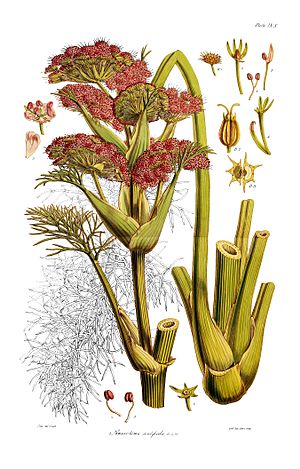Anisotome antipoda facts for kids
Quick facts for kids Anisotome antipoda |
|
|---|---|
 |
|
| Plates IX-X | |
| Conservation status | |
|
Invalid status (NZ TCS)
|
|
| Scientific classification | |
| Genus: |
Anisotome
|
| Species: |
antipoda
|
| Synonyms | |
|
Calosciadium antipodum (Hook.f.) Endl. ex Walp. |
|
Anisotome antipoda is a type of flowering plant that belongs to the Apiaceae family. This plant is special because it only grows in a few places: the Auckland, Campbell, and Antipodes Islands. These islands are located far south of New Zealand.
Contents
What Does Anisotome antipoda Look Like?
Anisotome antipoda is a perennial plant. This means it lives for more than two years. It can grow quite tall, reaching up to 1.2 meters (about 4 feet).
Leaves and Stems
The leaves at the bottom of the plant are shaped like an egg or an oval. They can be wide, from 0.1 to 0.6 meters across. They are also long, measuring 0.06 to 0.15 meters. These leaves are divided into smaller parts, almost like a fern leaf. They have 5 to 7 pairs of small leaflets. Each leaflet ends in a stiff, sharp point. The parts of the leaves that wrap around the upper stem are a bit swollen.
Flowers and Fruits
The main flower stalk, called a peduncle, is 20 to 100 millimeters long. Often, several of these stalks grow from the same spot on the stem. The whole flower cluster can be quite large, from 0.6 to 1.2 meters tall and 0.1 to 0.3 meters wide.
Each individual flower has a tiny stalk, called a pedicel, which is only about 0.5 millimeters long. The parts of the flower that receive pollen, called styles, are strong and 0.5 to 1 millimeter long. The tips of these styles, called stigmas, are reddish.
The flowers themselves are a beautiful dark pink to magenta color. You can see them blooming from October to March. After the flowers, the plant produces fruits from March to May.
Where Does Anisotome antipoda Grow?
This plant is found only on the Auckland, Campbell, and Antipodes Islands. It grows in many different places, from the coast all the way up to the mountains.
You can find it on cliffs and rocky ledges. It also likes wet areas with exposed peat (a type of soil made from decayed plants). Sometimes, it grows in open areas where many herbs grow together. It is often seen growing near another similar plant, A. latifolia.
How Is Anisotome antipoda Protected?
Anisotome antipoda has a special conservation status. In 2009, 2012, and again in 2018, it was classified as "At Risk - Naturally Uncommon." This means the plant is not very common in nature. It is considered "at risk" because it only grows in a very small area.
How Was Anisotome antipoda Named?
The first scientific description of Anisotome antipoda was made by Joseph Dalton Hooker in 1844. He found these plants while he was a surgeon on the ship HMS Erebus. This was during a big trip to Antarctica with other discovery ships, the Erebus and Terror.
Meaning of the Name
The genus name, Anisotome, comes from Greek words. It means "unequal sided," which likely refers to a feature of the plant's structure. The second part of the name, antipoda, is an adjective. It means "on the opposite side (of the world)." This name makes sense because the plant grows on islands far away, almost on the "opposite side" of the world from where it was first studied.
Can You Grow Anisotome antipoda?
It is fairly easy to grow Anisotome antipoda from fresh seeds. However, gardeners have noticed something interesting. Even when the plant seems to be growing very well, it can sometimes suddenly die.

